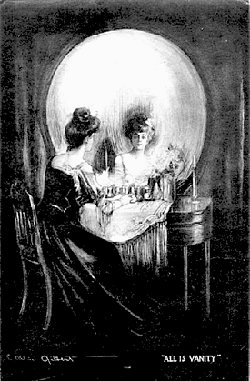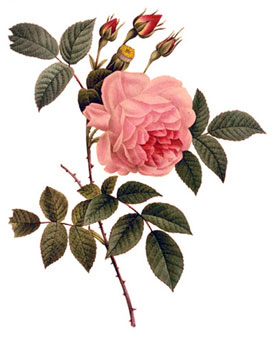|

 |
|
Hallo again to all.
We're waving to all our friends in the southern
latitudes from the frozen northern hemisphere, thinking about
ice, water, fire — and the taxonomy of sin. (We'll get
to sin in a moment.)
The season of Epiphany seems in a way to lengthen
Christmastide, those 12
days of unstinting revelry — if we do it right — in the things
of this world and our enfleshed life. But the Church in her
wisdom keeps us focussed on the incarnate world a while longer,
with all those camels, magi, silks and spices and strangeness.
 And then on to John, the wild baptizer, who also focusses us
on Tangible Things. (Stop any Sunday school child and ask what
she knows about John the Baptist and we suspect you'll be told
'locusts and wild honey and animal skins'.
In other words: Stuff.) And then there are, well, shoes! John
emphasizes his insignificance by saying he's not worthy to
unstrap Our Lord's sandal. Where else in the Bible are there
items all through this liturgical seasons that wouldn't be out
of place in Harrod's? And then on to John, the wild baptizer, who also focusses us
on Tangible Things. (Stop any Sunday school child and ask what
she knows about John the Baptist and we suspect you'll be told
'locusts and wild honey and animal skins'.
In other words: Stuff.) And then there are, well, shoes! John
emphasizes his insignificance by saying he's not worthy to
unstrap Our Lord's sandal. Where else in the Bible are there
items all through this liturgical seasons that wouldn't be out
of place in Harrod's?
The Baptism of Our Lord, observed by many provinces
of the Anglican Communion today, features water in a starring
role — flowing, sinuous, and, most likely,
rather dirty. Water adds its elemental nature to the season
of Epiphany, with its stars and gold and myrrh to frankincense.
But we race through the season of Epiphany, for in short order
we're bang up against the season of Lent. We leave behind the
world of the exotic, the fragrant, the glinting, and the organic
to enter for 40 days the world of dust and ashes, the grey
and the gritty. In Lent we shed all our finery and come up
against own designer brand of sin — yes, we're the designers!
— created from the portfolio of the seven deadly sins, monogrammed
with our own initials.
The Seven Deadly Sins. We've all heard about them. (And we know
which one seems to grab all the media attention.) The Church
has a long tradition of monitoring, categorising, and describing
sins, devising taxonomies that rival Linnæus. The sins have
names, numbers, categories, opposites, remedies, symbols, calories,
animals, biblical bases, and their own punishments in hell.
In mediæval times, tradition divided the seven deadly sins
into 'cold' and 'warm'. The cold sins are pride (superbia),
envy (invidia), anger (ira), and sloth (acedia). The 'warm
sins' are avarice (avaritia), gluttony (gula), and lust (luxuria).
 The
warm sins, the sins of the body, are the ones that today seem
to get all of the publicity and attention. And that's all topsy-turvy.
The cold sins, the sins of the heart, were traditionally far
more roundly condemned. Pride was seen as a colder, harsher,
more dangerous sin than any of the others, with anger following
closely. The cold sins were the ones you really really
wanted to avoid. The
warm sins, the sins of the body, are the ones that today seem
to get all of the publicity and attention. And that's all topsy-turvy.
The cold sins, the sins of the heart, were traditionally far
more roundly condemned. Pride was seen as a colder, harsher,
more dangerous sin than any of the others, with anger following
closely. The cold sins were the ones you really really
wanted to avoid.
The notion of seven deadly sins,
and their names, originated in the monastic communities of
the early church in the 5th century. Geoffrey Chaucer took
the sins to Canterbury in the 14th century, where the Archbishop,
Thomas Arundel, is said to have required preaching about the
seven deadly sins four times each year. It's a fair guess that
over the centuries there have been more sermons about sin than
all other topics combined. And yet, despite centuries of preaching,
we humans remain sinners. We admit it every
week in church. And we are forgiven every week. We rise from
our knees and stumble on.
So here we are, in the frozen coldness of the north. We'll do
our best to keep warmth and generosity and openness in our
hearts and lives and let the light
of Epiphany guide us through its few short weeks
to the gates of Lent and the time of ashes.
An ancient mystical tradition holds that a rose, if
burnt to ashes, could — given the right person at the right
time — be re-formed from those ashes and become the fresh dew-dappled
bloom that once it was. Imagine: the deadest of dead things,
a pile of dusty grey cinder, slowly rising in a small cloud-like
waft of smoke, idly shaping itself into the stem, thorns, and
blossom of a rose — and then becoming a very rose itself:
It came, a flow'ret bright,
Amid the cold of winter,
When halfspent was the night.
See you next week, in the space between the rose and the ashes.

All of us at Anglicans Online
|

